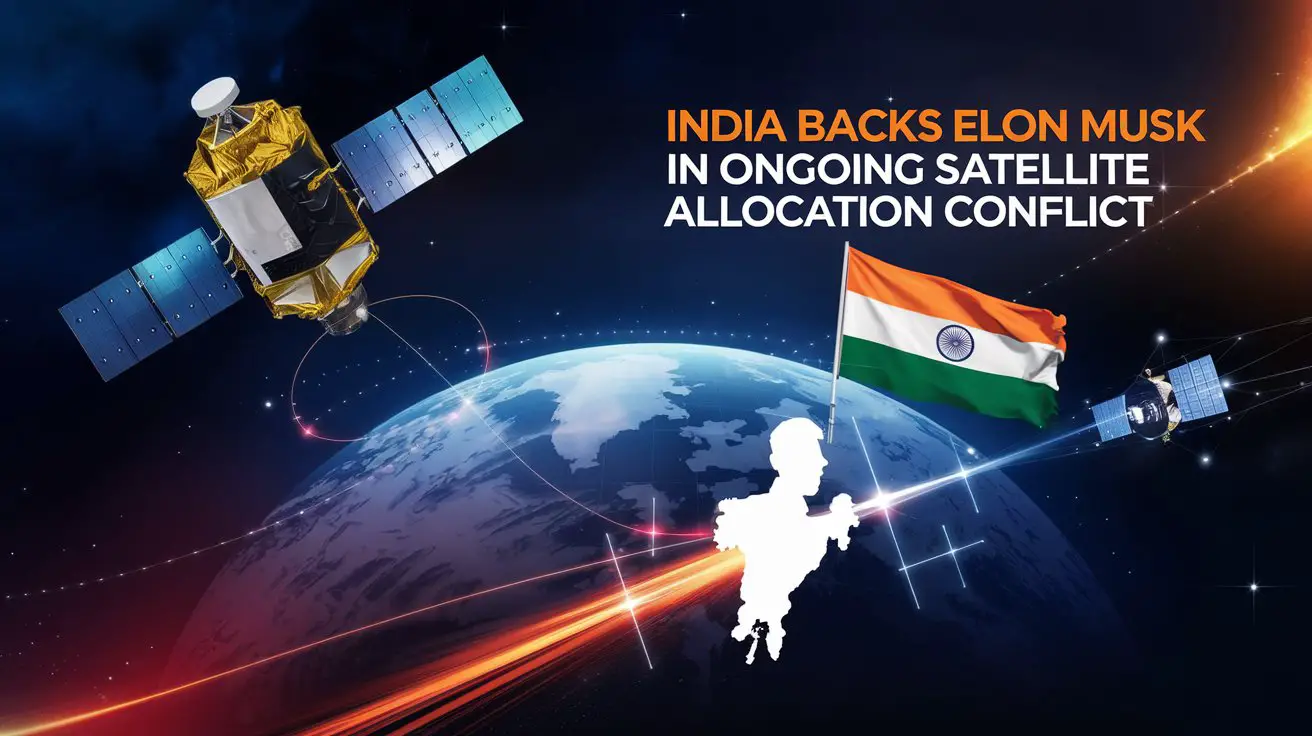In the rapidly evolving world of satellite internet services, a new battleground has emerged: the allocation of satellite spectrum. This technical but critical issue lies at the heart of global communications, space exploration, and emerging broadband technologies. One of the most prominent figures at the center of this dispute is Elon Musk, the CEO of SpaceX and founder of Starlink, his ambitious satellite internet service. As satellite spectrum battles rage on in various parts of the world, India has recently found itself backing Musk in this ongoing conflict, supporting his position in the allocation of spectrum for satellite services.
This article dives into the details of the spectrum conflict, the importance of satellite spectrum for global broadband access, and why India is siding with Musk on this contentious issue. It also explores the broader implications for the satellite internet industry, regulatory challenges, and what this partnership could mean for both SpaceX and India’s future.
The Basics of Satellite Spectrum and Why It Matters
Satellite spectrum refers to the specific frequency bands used by satellites to communicate with Earth-based stations. These frequencies are critical for transmitting data, voice, and video across vast distances. Without proper allocation of these frequencies, the ability to deliver reliable and high-speed internet to underserved or rural areas would be severely compromised.
As satellite-based internet services become more popular, companies like SpaceX (with Starlink), OneWeb, and Amazon’s Project Kuiper are launching constellations of low-Earth orbit (LEO) satellites that require large swathes of spectrum to operate effectively. However, satellite spectrum is a finite resource, and its allocation is tightly regulated by government agencies such as the Federal Communications Commission (FCC) in the United States and the Telecom Regulatory Authority of India (TRAI) in India, as well as international bodies like the International Telecommunication Union (ITU).
The need for equitable and efficient spectrum allocation has become even more pressing as the demand for global broadband access surges, especially in remote areas where traditional infrastructure like fiber optics is not feasible. Musk’s Starlink service aims to deliver high-speed internet to underserved regions by deploying a massive constellation of LEO satellites. However, regulatory hurdles, specifically spectrum allocation, have become one of the largest obstacles standing in his way.
Elon Musk’s Starlink and Its Ambitions
Elon Musk’s Starlink project is one of the most ambitious undertakings in the realm of satellite internet. The company has already launched over 4,000 satellites into low-Earth orbit, aiming to blanket the planet with reliable internet coverage. Starlink’s primary goal is to bring broadband access to rural and underserved areas, where conventional broadband solutions such as fiber or cable are not available or economically viable.
Starlink’s unique selling point lies in its ability to provide faster, low-latency internet compared to traditional satellite internet services that rely on higher geostationary orbits. With thousands of satellites orbiting closer to Earth, Starlink can deliver higher-speed connections, positioning itself as a revolutionary option for millions of potential users around the globe.
However, in order to function optimally, Starlink requires access to large portions of the satellite spectrum. The problem arises when other companies and governments also seek to claim parts of that same spectrum, leading to disputes over who gets access, how much they get, and under what terms. This is where the conflict over satellite spectrum allocation heats up.
The Ongoing Spectrum Conflict
The crux of the conflict stems from the increasing number of players looking to establish their own satellite constellations, creating intense competition for limited spectrum resources. Companies like OneWeb, Amazon’s Project Kuiper, and even national space agencies are all vying for their share of the satellite spectrum. These competing claims often result in legal battles, regulatory challenges, and international negotiations.
In India, the competition for satellite spectrum has intensified as the government seeks to expand internet access across its vast and diverse population. Starlink, OneWeb, and other providers have been eyeing the Indian market for its immense growth potential. Starlink, in particular, has garnered significant attention due to Musk’s plans to launch satellite broadband services in India, where millions of people in rural areas still lack high-speed internet access.
As this battle for spectrum unfolds, India’s position has become more aligned with Musk’s vision. The Indian government has shown interest in supporting Starlink, as it sees Musk’s satellite internet service as a viable solution for bridging the digital divide in rural and remote regions. India has long struggled with inadequate broadband infrastructure in rural areas, and satellite internet could be the key to unlocking economic and educational opportunities for millions of citizens.
Why India is Siding with Elon Musk
India’s support for Musk in the satellite spectrum allocation conflict can be traced to several key factors. First and foremost is the potential for Starlink to rapidly expand broadband access in areas that have been underserved for years. India has a massive population, with a significant portion living in rural areas where traditional broadband infrastructure is lacking. Satellite internet offers a faster, more efficient solution compared to the lengthy and expensive process of laying fiber optic cables across the country.
From an economic perspective, the introduction of affordable and high-speed satellite internet could spur economic growth, improve access to education, and enhance healthcare services in rural communities. The Indian government recognizes this potential and is eager to leverage Starlink’s technology to meet its own development goals. Additionally, India’s focus on becoming a global leader in digital transformation aligns with Musk’s ambitious space projects, making the collaboration mutually beneficial.
Moreover, India’s support for Musk could also be seen as part of a broader geopolitical strategy. As tensions between China and India simmer over technological dominance in Asia, aligning with SpaceX and Elon Musk strengthens India’s position in the space race. By partnering with one of the world’s leading private space companies, India signals its intention to play a key role in the next generation of space technologies, from satellite internet to space exploration.
Regulatory Challenges in India
Despite India’s backing of Elon Musk, the path to Starlink’s full deployment in the country is far from smooth. Regulatory hurdles remain a significant barrier to the widespread adoption of satellite internet services. The Telecom Regulatory Authority of India (TRAI), along with the Department of Telecommunications (DoT), oversees the allocation of spectrum for telecommunications services, and the process can be slow and bureaucratic.
Furthermore, other satellite providers, such as OneWeb (which has ties to the Bharti Group, an Indian conglomerate), are also lobbying for their share of the spectrum. The Indian government will need to carefully navigate the competing interests of multiple providers while ensuring that its own citizens benefit from expanded internet access. This balancing act will require regulatory reforms and efficient spectrum allocation strategies to accommodate the increasing demand for satellite broadband.
Another key issue is pricing. While Starlink offers high-speed internet, its service is currently priced at a premium compared to local broadband providers. For Starlink to succeed in India, it will need to find a way to make its services more affordable for the average consumer, particularly in rural areas where disposable income is lower. This is where India’s regulatory bodies could play a crucial role in shaping the market and incentivizing lower prices for satellite internet services.
The Global Implications of the Conflict
India’s support for Elon Musk in the satellite spectrum conflict isn’t just significant for India and Starlink—it has global implications as well. The battle for satellite spectrum is not confined to a single country or region. It is a global issue with ramifications for the future of global communications, space exploration, and internet access. As more companies and governments launch satellite constellations, the need for a coordinated, international framework for spectrum allocation becomes increasingly urgent.
The spectrum battle also highlights the growing privatization of space. Private companies like SpaceX and OneWeb are playing a leading role in shaping the future of space-based communications. While this brings innovation and investment, it also raises concerns about monopolization and the concentration of power in the hands of a few tech giants. Governments around the world will need to address these concerns while fostering competition and innovation in the satellite internet sector.
In addition, the spectrum conflict reflects the geopolitical dimension of space exploration. Countries like the United States, India, and China are all vying for leadership in space technologies, and satellite internet is one of the key arenas in which this competition is playing out. India’s support for Musk could strengthen its ties with the U.S. and position it as a key player in the global space race, particularly as it develops its own space exploration capabilities through organizations like the Indian Space Research Organisation (ISRO).
Conclusion: A Strategic Partnership with Far-Reaching Implications
India’s backing of Elon Musk in the ongoing satellite spectrum allocation conflict is more than just a strategic partnership—it’s a reflection of the future of space and communications technologies. With the promise of high-speed internet access for underserved regions, satellite internet services like Starlink have the potential to revolutionize global connectivity and bridge the digital divide in countries like India.
However, challenges remain. Regulatory hurdles, competition from other satellite providers, and the need for affordable pricing will all need to be addressed for this partnership to reach its full potential. As India and SpaceX continue to navigate these complexities, the outcome of this spectrum battle could shape the future of global communications and digital transformation.
For now, it is clear that India sees the value in supporting Elon Musk’s vision for satellite internet, and the stakes couldn’t be higher. As the world becomes increasingly connected through digital technologies, the race for satellite spectrum is just beginning—and India is positioning itself to be a key player in that race.





